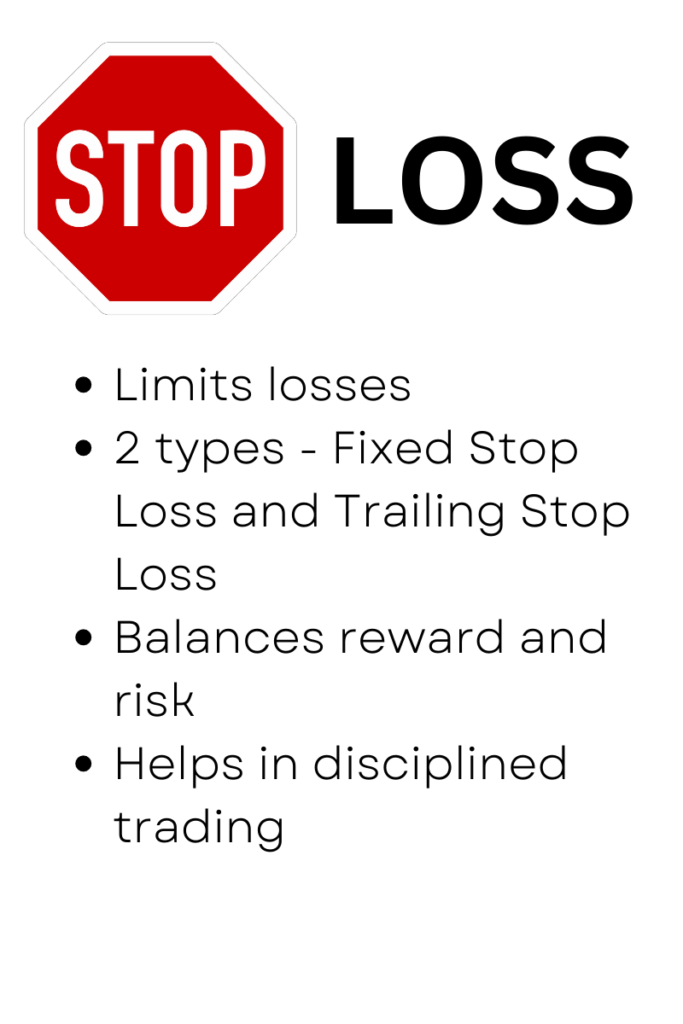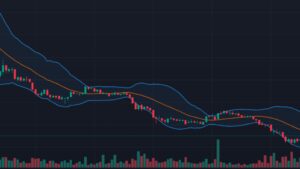A stop loss is used to limit the traders loss on a particular security position. Simply explained, a stop loss is a method used to limit losses. Let us understand the concept with a few examples.
Mahi is a trader in the stock market. He wants to sell shares of ‘Joe Black Ltd’ which are currently trading at Rs 1,200 per share in the stock market. Mahi places a sell order with a stop loss at Rs 1,180 per share. It means that if the price of the share falls below Rs 1,180 then the broker will sell the shares owned by Mahi and avoid further losses.
Asmi buys shares of ‘Joe Black Ltd’ at Rs 1,000 per share. Soon the share price falls to Rs 900 per share. Asmi wants to limit her losses. So she places a sell order with a stop loss at Rs 850 per share. This means, that if share price falls below Rs 850 per share, Asmi’s broker will sell the shares and limit her losses to Rs 150 (1000-850) per share.
Types of Stop Loss Orders
There are 2 types of stop loss order. Fixed stop loss order and Trailing stop loss order. Let us understand each of these.
Fixed Stop Loss
In a fixed stop loss, the trigger price is pre-determined. Eg. A stop loss order at Rs 800, means the stop loss will trigger the moment the share price falls below Rs 800. This is a fixed stop loss order.
Trailing Stop Loss
A trailing stop loss is set as a percentage of the share price. The order to sell is triggered if the market price falls below the pre determined percentage. Eg. A stop loss order is set at 10% of current share price of Rs 1000. Now if the share price falls below Rs 900, the stop loss sell order will be triggered as the 10% condition is fulfilled.
Similarly, if share price increases by 10% to Rs 1100 and then falls by 10% to Rs 990. Then the stop loss will be triggered and the share will be sold at Rs 990 as the 10% condition is fulfilled. So in a trailing stop loss the price is not fixed. The percentage is fixed.

How to use a Stop loss
A stop loss is an effective risk management and loss controlling tool if used effectively. It is a must for regular traders and speculators. It is widely used in the stock markets and currency markets. The primary goal of a stop loss is to limit losses. The stop loss should be used for all day trading deals and speculative trading. Generally, the stop loss is set around 5% of the current share price.
It helps in preventing emotional trading and related losses. Sometimes people ‘fall in love’ with a stock and end up making massive losses because they do not exit their positions in time. A stop loss prevents the occurrence of such a situation.
Advantages & Disadvantages of Stop Loss
| Advantages | Disadvantages |
| It minimizes losses. | Stop loss may get activated by the short term market fluctuations. |
| An automatic sale order is placed when the stop loss is triggered. The trader does not need to spend time monitoring the share price to make a transaction. | One may end up selling stocks sooner, which would limit the profit potential. Eg. A 5% stop loss on a share which fluctuates more than 10% weekly may limit profits. |
| It helps to manage risk and reward as each trader can place a stop loss based on one’s own risk appetite and reward expectation. | Traders have to use their judgement when setting stop loss. This can get tricky. |
| Use of stop loss leads to disciplined trading which helps to stick to one’s financial plan. Stop loss removes the possibility of emotional trading losses. | Brokers charge for executing stop loss orders. Trading with stop loss orders can be expensive in terms of brokerage. |
Stop Loss Order v/s Market Order
A stop-loss order executes a sale of securities when the price falls below a predetermined limit. A market order is issued to a broker to conduct trade (both buying and selling) at the prevailing market price (i.e. current market price).
Stop-loss orders are used to reduce trading risk. Market orders aim to increase liquidity in the stock market by removing the bid-ask spread difference. A market order is the most basic form of trade order placed in a stock market.
Stop Loss Order v/s Limit Order
Limit orders execute a trade of security if the price reaches a pre-set value. A buy limit order facilitates the purchase of any securities if the price falls below the given limit. A sell limit order is executed if the price rises above the given limit. Limit orders are used to maximise profitability. Whereas stop loss orders are used to minimise losses.



